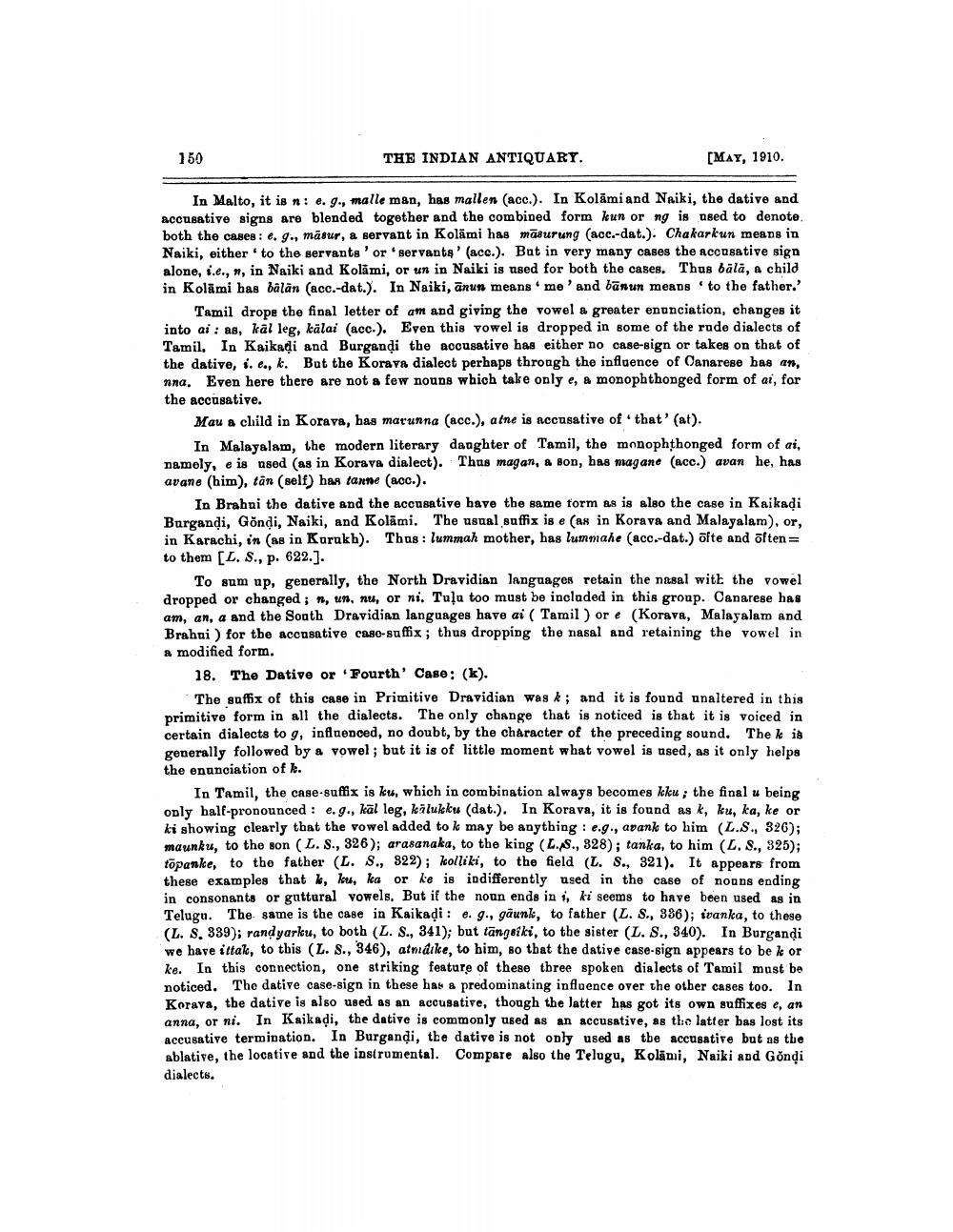________________
150
THE INDIAN ANTIQUARY.
[MAY, 1910.
In Malto, it is nie. g., malle man, has mallen (acc.). In Kolami and Naiki, the dative and accusative signs are blended together and the combined form koun or ng is used to denote both the cases : e. g., māsur, a servant in Kolāmi has māsurung (acc.-dat.). Chakarkun means in Naiki, either to the servants' or servants' (acc.). But in very many cases the accusative sign alone, i.e., n, in Naiki and Kolami, or un in Naiki is used for both the cases. Thus bāla, a child in Kolami has bālän (acc.-dat.). In Naiki, ānun means me' and bānun means 'to the father.'
Tamil drope the final letter of am and giving the vowel a greater enunciation, changes it into ai : as, kal leg, kälai (acc.). Even this vowel is dropped in some of the rude dialects of Tamil, In Kaikadi and Burgandi the accusative has either no case-sign or takes on that of the dative, i. e., k. But the Korava dialect perhaps through the influence of Canarese has an, nna. Even here there are not a few nouns which take only e, a monophthonged form of ai, for the accusative.
Mau a child in Korava, has marunna (acc.), atne is accusative of that'(at).
In Malayalam, the modern literary danghter of Tamil, the monophthonged form of ai, namely, e is used (as in Koraya dialect). Thus magan, a son, has magane (acc.) avan he, has avane (him), tan (self) has tanne (acc.).
In Brahui the dative and the accusative have the same form as is also the case in Kaikadi Burgandi, Göndi, Naiki, and Kolāmi. The usual suffix is e (as in Korava and Malayalam), or, in Karachi, in (as in Kurukb). Thus: lummah mother, has lummahe (acc.-dat.) ofte and often = to them [L. S., p. 622.].
To sum up, generally, the North Dravidian languages retain the nasal with the vowel dropped or changed; n, un, nu, or ni. Tuļu too must be included in this group. Canarese has am, an, a and the South Dravidian languages have ai (Tamil) or e (Korava, Malayalam and Brahui ) for the accusative caso-suffix; thus dropping the nasal and retaining the vowel in a modified form.
18. The Dative or Fourth' Case: (k).
The suffix of this case in Primitive Dravidian was k; and it is found unaltered in this primitive form in all the dialects. The only change that is noticed is that it is voiced in certain dialects to g, influenced, no doubt, by the character of the preceding sound. Thek is generally followed by a vowel ; but it is of little moment what vowel is used, as it only helps the enunciation of k.
In Tamil, the case-suffix is ku, which in combination always becomes kku; the final u being only half-pronounced : e.g., kāl leg, kalukku (dat.). In Korava, it is found as k, ku, ka, ke or ki showing clearly that the vowel added to k may be anything : e.g., arank to him (L.S., 326); maunku, to the son (L. S., 326); arasanaka, to the king (L. S., 328); tanka, to him (L. 8., 325); töpanke, to the father (L. S., 822); kolliki, to the field (L. S., 321). It appears from these examples that l, loue, ka or ke is indifferently used in the case of nouns ending in consonants or guttaral vowels. But if the noun ends in 4, ki seems to have been used as in Telugu. The same is the case in Kaikadi : e. g., gaunk, to father (L. S., 886); ivanka, to these (L. S. 389); rand yarku, to both (L. S., 341); but tāngaiki, to the sister (L. S., 340). In Burgandi we have ittak, to this (L. S., 346), atnidike, to him, so that the dative case-sign appears to be k or ke. In this connection, one striking feature of these three spoken dialects of Tamil must be noticed. The dative case-sign in these has a predominating influence over the other cases too. In Koraya, the dative is also used as an accusative, though the latter has got its own suffixes e, an anna, or ni. In Kaikadi, the dative is commonly used as an accusative, as the latter bas lost its accusative termination. In Burgandi, the dative is not only used as tbe accusative but as the ablative, the locative and the instrumental. Compare also the Telugu, Kolami, Naiki and Gôndi dialects.




